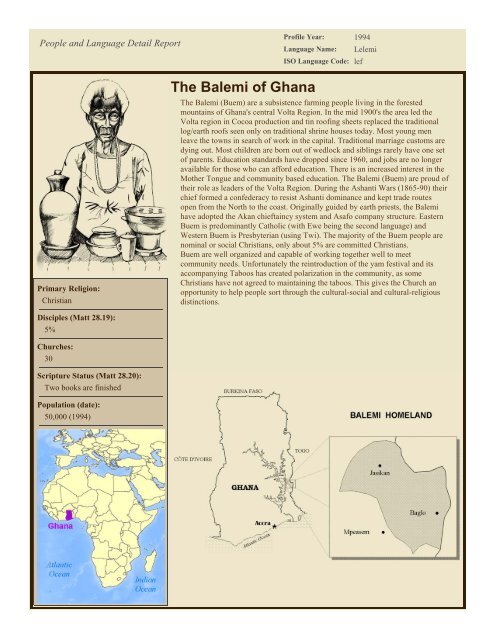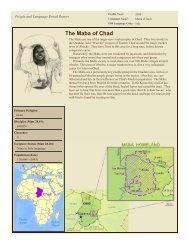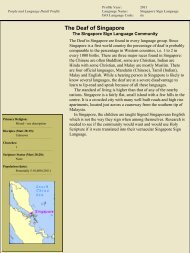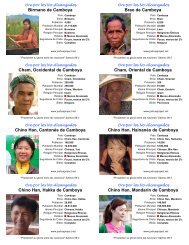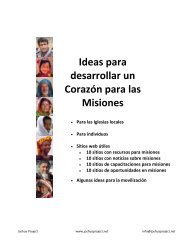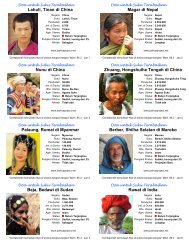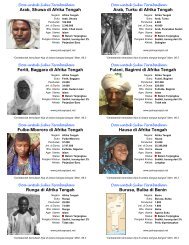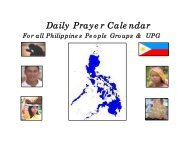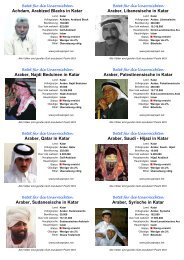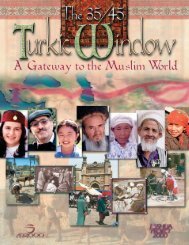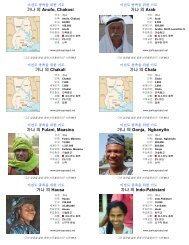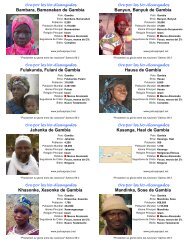expanded PDF profile - Joshua Project
expanded PDF profile - Joshua Project
expanded PDF profile - Joshua Project
Create successful ePaper yourself
Turn your PDF publications into a flip-book with our unique Google optimized e-Paper software.
People and Language Detail Report<br />
Profile Year: 1994<br />
Language Name: Lelemi<br />
ISO Language Code: lef<br />
Primary Religion:<br />
Christian<br />
The Balemi of Ghana<br />
The Balemi (Buem) are a subsistence farming people living in the forested<br />
mountains of Ghana's central Volta Region. In the mid 1900's the area led the<br />
Volta region in Cocoa production and tin roofing sheets replaced the traditional<br />
log/earth roofs seen only on traditional shrine houses today. Most young men<br />
leave the towns in search of work in the capital. Traditional marriage customs are<br />
dying out. Most children are born out of wedlock and siblings rarely have one set<br />
of parents. Education standards have dropped since 1960, and jobs are no longer<br />
available for those who can afford education. There is an increased interest in the<br />
Mother Tongue and community based education. The Balemi (Buem) are proud of<br />
their role as leaders of the Volta Region. During the Ashanti Wars (1865-90) their<br />
chief formed a confederacy to resist Ashanti dominance and kept trade routes<br />
open from the North to the coast. Originally guided by earth priests, the Balemi<br />
have adopted the Akan chieftaincy system and Asafo company structure. Eastern<br />
Buem is predominantly Catholic (with Ewe being the second language) and<br />
Western Buem is Presbyterian (using Twi). The majority of the Buem people are<br />
nominal or social Christians, only about 5% are committed Christians.<br />
Buem are well organized and capable of working together well to meet<br />
community needs. Unfortunately the reintroduction of the yam festival and its<br />
accompanying Taboos has created polarization in the community, as some<br />
Christians have not agreed to maintaining the taboos. This gives the Church an<br />
opportunity to help people sort through the cultural-social and cultural-religious<br />
distinctions.<br />
Disciples (Matt 28.19):<br />
5%<br />
Churches:<br />
30<br />
Scripture Status (Matt 28.20):<br />
Two books are finished<br />
Population (date):<br />
50,000 (1994)
The Balemi of Ghana<br />
Item Name<br />
Have They Heard The Gospel<br />
Call Themselves Christian (%) 98<br />
Believe In Jesus As God & Only Savior (%) 5%<br />
Comment (Jesus As God & Only Savior)<br />
Number Of Pastors 30<br />
Number Of Missionaries Working 2<br />
Number Of Communities<br />
Number Of Churches 30<br />
Item Note<br />
possibly less than 2500 believers<br />
There are 17 listed Buem communities<br />
Is The Word Of God Translated Yes - Mark's Gospel published 1984 and Acts published 1992<br />
Translation Medium<br />
Any Hinderance To Scripture Distribution<br />
Forms Of Gospel Presentation Available (Summary)<br />
What Kind Of Missionaries Are Needed<br />
Population All Countries<br />
Printed<br />
World Population For This People 50000<br />
World Population (Date) 1994<br />
World Population (Urban Percent) 5000<br />
Comment (World Population)<br />
Countries Where People Group Lives<br />
Country Name<br />
Country Name<br />
Geography & Environment<br />
Location<br />
Country<br />
Ecosystem Type<br />
Geological Type<br />
Elevation<br />
Many pastors are non-Buem speakers, who use a dominant trade language, not the<br />
Buem MT.<br />
Tapes of Christian Songs.<br />
Profile Summary<br />
Yes for Bible translation completion. People are gaining hope in the educational<br />
system as education that is culturally appropriate and good vocational training has<br />
been recently introduced. This will benefit the existing lifestyle. Although many<br />
recognize that outside languages take their children away from the community and<br />
therefore it is a barrier to reaching these goals. The use of Lelemi would assist them in<br />
these schemes and would be of benefit to the Buem community.<br />
Ghana has had a 6% population growth rate (in some years the highest in the world).<br />
Among the Balemi the population increase is said to be 10%.<br />
Ghana<br />
Ghana<br />
Longitude .5E<br />
Latitude 7.4N<br />
Climate<br />
Comments (Geography & Environment)<br />
Language & Linguistics<br />
Comment (Language)<br />
Alternate Language Names<br />
Attitude Towards Mother Tongue<br />
Percent Monolingual (%) 10<br />
Second Languages 20<br />
In the Jasikan District of the Volta Region in the eastern part of Ghana. The area is<br />
located between southern Ewe speaking peoples and northern Twi speaking peoples<br />
and other Ghana-Togo Mountain Languages in the east and west.<br />
Ghana<br />
Deciduous Forest<br />
Mountain Slopes<br />
200-500 m<br />
hot and humid with seasonal rains.<br />
Bodada is the traditional centre, Jasikan the district headquarters. There are 21 Buem<br />
localities, 18 of which are larger ones.<br />
Most everyone uses a trade language for market. But average comprehension scores<br />
were 39% for graded testing.<br />
Lefana and Buem (from Twi).<br />
Very receptive<br />
Group Description<br />
Group Description<br />
Group Description<br />
Group Description
The Balemi of Ghana<br />
Item Name<br />
Other Mother Tongues Of This Group<br />
Other Mother Tongues Of This Group<br />
Item Note<br />
ENGLISH<br />
ENGLISH<br />
Comment (On Other Mother Tongues) English 15 - 20% : Ewe 30 - 40% : Twi 30 - 40%<br />
Eastern Buem use no Twi and there Ewe scores ran at 39% average comprehension.<br />
Western Buem use no Ewe and there Twi scores ran at 69% average comprehension.<br />
Linguistically Related Languages<br />
Linguistically Related Languages<br />
Comments (Related Languages)<br />
Neighboring Languages<br />
Literacy<br />
Adult Literacy Percentage 30<br />
Literacy Attitude<br />
Active Literacy Program<br />
Publications In Vernacular 20<br />
Comment (Literacy)<br />
Economics<br />
Subsistence Type<br />
Average Annual Income<br />
Occupation<br />
Income Sources<br />
Products / Crafts<br />
Trade Partners<br />
Modernization / Utilities<br />
Comment (Economy)<br />
Community Development<br />
Health Care (Quality)<br />
Comment (Health Care)<br />
Diet (Quality)<br />
Comment (Diet)<br />
Water (Quality)<br />
Comment (Water)<br />
Shelter Description<br />
Energy/Fuel (Quality)<br />
Comment (Energy)<br />
AKPAFU-LOLOBI<br />
AKPAFU-LOLOBI<br />
Likpe/Akpafu-Lolobi/Santrokofi - these are all related languages and could probably<br />
use a CARLA project for their own translations based on Lelemi.<br />
AKAN<br />
Very receptive<br />
Yes<br />
30% are literate in Twi or Ewe. 5% are literate in English. Literacy classes in the<br />
Buem Mother Tongue are active among adults - Lelemi is now being introduced in<br />
primary schools. For many people eyesight is a problem, they cannot see the writing.<br />
Agriculturalists<br />
200,000 cedis<br />
Farming, teaching, trading. Professionals have moved out to Accra men farm the<br />
staples, which primarily go into subsistence. Women farm additional crops, many of<br />
which are sold as cash crops. Women control the trading of surplus and thus control<br />
most of the money.<br />
Surplus of substance farming (intercrossing system: yams and corn, followed by rice<br />
and groundnuts, followed by plantain and cassava).<br />
From the 30s to the 60s,the cocoa economy was strong and Buem would tenant out<br />
their land to Ewe immigrants for a share of the profits. The fall of the cocoa market<br />
and disease in the trees led to lower standards of living and many land disputes as<br />
tenants attempted to claim the land for general farming. In the east, Buem have sold<br />
their land which has brought economic hardship.<br />
foodstuff (plantain, cocoyam, cassava, Palm oil, maize, rice), pottery (done by<br />
women), carpentry (stools), baskets, soap<br />
Togolese, Kotokoli, Ewe, Akans<br />
One or two grinding mills<br />
There are regular shortages of food each year. Problems are compounded by drought<br />
or excessive rain. The general economic situation is improving since the mid-80s.<br />
Poor<br />
Health care good in towns, poor in outlying areas. Women are aware of the health<br />
needs and have started a clinic.<br />
There are six health care posts, one private hospital and one clinic in Jasikan.<br />
Most people use traditional medicine.<br />
Good<br />
The Buem eat fufu and soup with fish daily, vegetables, fruit. Meat is rare.<br />
Fair<br />
Group Description<br />
Group Description<br />
Group Description<br />
There are a few boreholes. Most of the water comes from the streams and rivers, some<br />
of which dry out during the dry season, which entails far walking to fetch water.<br />
Rectangular mud houses with zinc roofing. In one compound there are about 20 people<br />
(the father, wife, children and their wives.<br />
Fair<br />
Electricity in towns. In villages: firewood and kerosene lanterns.
The Balemi of Ghana<br />
Item Name<br />
Item Note<br />
Clothing<br />
Ghanaian cloth, western second hand clothing<br />
Transportation<br />
2nd and 3rd class roads to all town centers.<br />
Infant Mortality Rate 5%<br />
Life Expectancy 70-75<br />
Leading Cause Of Death<br />
fever, jaundice, old age<br />
Society & Culture<br />
Family Structures<br />
Neighbor Relations<br />
Authority / Rule<br />
Social Habits/Groupings<br />
Cultural Change Pace<br />
Identification With National Culture<br />
Self Image<br />
Judicial / Punishment System<br />
Celebrations<br />
Recreations<br />
Art Forms<br />
Media<br />
Local Language Broadcasting<br />
Attitude To Outsiders<br />
Attitude To Change<br />
Youth<br />
Labor and tasks (6-12 year olds)<br />
Youth Problems (Teens)<br />
Youth Greatest Needs (teens)<br />
Patrilineal - Clan structure - Family heads - when a parent dies, the children are<br />
assigned another.<br />
Boundary disputes are sometimes a concern with neighboring groups.<br />
Chieftancy is well established (traditional council). The paramount chief is supported<br />
by a council of chiefs. The local chiefs by a council of elders. Each clan has its chief.<br />
Parallel system among women: queen mother, women clan chiefs, family heads.<br />
Group Description<br />
Men and women live separate lives as far as eating apart, working apart, socializing<br />
apart. The exception to this is in committed Christians' homes, procreation is the only<br />
joint feature.<br />
The Town Development Committee (local CDR) is an elected body and is responsible<br />
for organizing communal labor for local projects (construction or repair of public<br />
buildings or roads)<br />
Medium<br />
Similar<br />
Prestigious<br />
Traditional chieftancy concerned with domestic affairs functions side by side with the<br />
national legal system. The traditional system is based on reconciliation and restitution.<br />
The Yam festival and the festival of the local shrine have had attempts at revival since<br />
1990, both failed.<br />
Funerals, football matches, church functions and dances.<br />
Pottery, wood carving, functional basketry and some Kente weaving.<br />
None<br />
None<br />
Somewhat receptive<br />
Somewhat receptive<br />
Group Description<br />
Young men work on peoples farms by day (hired labor). They actively participate in<br />
communal labor if under 50 years old.<br />
Little leadership - no guidance on handling the culture changes they are experiencing.<br />
Literature, education with moral guidance suitable to their cultural background.<br />
Education<br />
Primary Schools 30<br />
Percent Of Eligible Students Enrolled 100<br />
Teacher To Pupil Ratio 45<br />
Language Of Instruction Early Years<br />
Language Of Textbooks Early Years<br />
Language Of Instruction Later Years<br />
Language Of Textbooks Later Years<br />
Comment (Education)<br />
English<br />
English<br />
English<br />
English<br />
Group Description<br />
Some mix with Ewe/Twi speakers. In the outlying areas there are few Ewes/Akans.<br />
They live in separate enclaves when present.<br />
Oral Lelemi is used in first three grades.<br />
Secondary education is not adequate. There is one secondary school (in Jasikan) for<br />
the whole Lelemi area. A new secondary school is trying to be put up in Bodada. Lack<br />
of funds makes it impossible to sustain it.
The Balemi of Ghana<br />
Item Name<br />
Church Growth<br />
Reached Status<br />
Item Note<br />
Engaged<br />
Total Baptized 40000<br />
Lay Leaders 30<br />
Christian Clinics/Hospitals 1<br />
Christian Literacy Centers 1<br />
Comment (Church Growth)<br />
Religion & Response<br />
Religious Practices & Ceremonies<br />
Attitude To Christianity<br />
Attitude To Religious Change<br />
Resistance / Receptivity<br />
Religious Analogies & Bridges<br />
Spiritual Climate And Openness<br />
Comment (Religion)<br />
Recommended Approaches<br />
Current Needs<br />
Items For Prayer<br />
History Of Christianity In Group<br />
Year Began 1885<br />
By Whom<br />
Significant Events<br />
Scripture<br />
Translation Status<br />
Available Scripture<br />
Form Of Scripture Available<br />
Scripture Use 5<br />
Scripture Use<br />
Comment (Scripture)<br />
Christian Literature And Media Status<br />
There is a rise in interest in Pentecostal churches in the area, as people look to the<br />
church for problem solving issues in these economically depressed times.<br />
Traditional funeral customs still in force.<br />
Somewhat receptive<br />
Somewhat receptive<br />
Early in the Century they responded favorably, however without much literate<br />
awareness they have become nominal or social Christians. The breakdown of the<br />
chieftaincy system due to both economic and religious factors is an interesting<br />
development.<br />
Rompi (Akan) a Ram is substituted for a child, it is captured to be killed instead of<br />
announcing a chiefs death. Aburam myth (1st chief) gave\ killed himself to avoid<br />
conquer by Akans.<br />
Positive now that Scripture is becoming available in the MT.<br />
Though 98% claim to be Christians, 95% are animists so the Buem people seem to be<br />
both Christian and Animist In actual fact about 5% are committed/literate Christians.<br />
Juju or witchcraft is a major fear among Christians and non-Christians. Christianity<br />
was imposed on the Buem people in a trade language, in order to attend school<br />
children had to be baptized.<br />
Through Mother Tongue, Literacy and S-I-U activities.<br />
Literature is the bottle neck to teaching.<br />
1. Contextualisation of the Gospel in Buem thought - via translation process.<br />
2. Sound teaching, opportunity for discussion.<br />
3. Church unity and cooperation.<br />
Presbyterian<br />
Father A.O. Dogli ordained in Lome (1st West African Priest 1922 - a man from<br />
Eastern Buem). 1904 Basel missionaries (using Twi) replaced the Bremen missionaries<br />
(using Ewe) in Western Buem. 1929 - Presbyterian church heals rift by allowing Twi<br />
in W. Buem. 1930 - Father Dogli rejected by Buem Elders of W. Buem in bid to use<br />
Lelemi in schools. 1970 - R.C. Church leaders burn Father Dogli's shipment of Lelemi<br />
misals at Keta. 1979 - GILLBT identifies Lelemi as Bitrans need. 1980 Bitrans project<br />
begun.<br />
In Progress<br />
Portions<br />
Printed and Audio<br />
Majority of churches<br />
Old Testament translation is in progress due to the initiative of some members of the<br />
people group.<br />
Literature Available Only short Bible Texts, New Testament is expected in 1996.<br />
Audio Recordings Available<br />
Two scripture songs tapes.<br />
Status of Christianity<br />
Status of Christianity<br />
Status of Christianity<br />
Status of Christianity<br />
Status of Christianity
The Balemi of Ghana<br />
Item Name<br />
Films Available<br />
Radio Programs Available<br />
Videos Available<br />
Audio Visual Available<br />
Item Note<br />
None<br />
None<br />
None<br />
None


